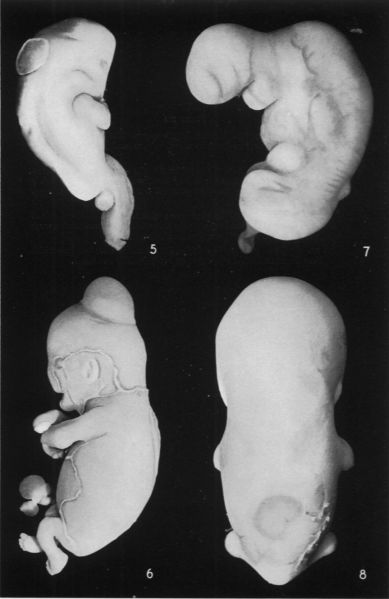File:Ingalls1932b plate100.jpg

Original file (863 × 1,329 pixels, file size: 197 KB, MIME type: image/jpeg)
Plate 100
Fig. 5. Embryo No. 210. Greatest length 15mm. Large thin-walled bleb in the midline over the rhombencephalon. Much deformity in the body generally.
Fig. 6. Embryo No. 597 B. The smaller of a pair of binoval twins, greatest length 32.5mm. Very large, rather thick-walled bleb in the midline of head, just behind vertex. Extensive desquamation, malformed hands and cord.
Fig. 7. Embryo No. 407. Greatest length 7 mm. Small bleb-like elevation of epithelium in the midline of the back. Head small and malformed.
Fig. 8. Embryo No. 442. Greatest length 26 mm. Dark patch in lower dorsal region; on the right and below can be seen the borders of the larger area. Laterally the epidermal thickenings are very conspicuous. There is also a very definite transverse band across the forehead.
Reference
Ingalls NW. Studies in the pathology of development: II. Some aspects of defective development in the dorsal midline. (1932) Am J Pathol. 8(5): 525-556 PMID 19970035
Cite this page: Hill, M.A. (2024, April 26) Embryology Ingalls1932b plate100.jpg. Retrieved from https://embryology.med.unsw.edu.au/embryology/index.php/File:Ingalls1932b_plate100.jpg
- © Dr Mark Hill 2024, UNSW Embryology ISBN: 978 0 7334 2609 4 - UNSW CRICOS Provider Code No. 00098G
File history
Click on a date/time to view the file as it appeared at that time.
| Date/Time | Thumbnail | Dimensions | User | Comment | |
|---|---|---|---|---|---|
| current | 08:53, 14 October 2020 |  | 863 × 1,329 (197 KB) | Z8600021 (talk | contribs) | ===Reference=== {{Ref-Ingalls1932b}} {{footer}} |
You cannot overwrite this file.
File usage
The following page uses this file:



